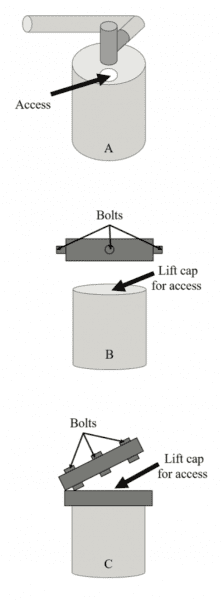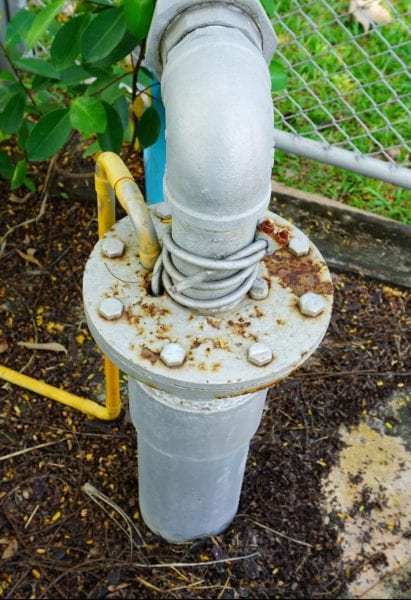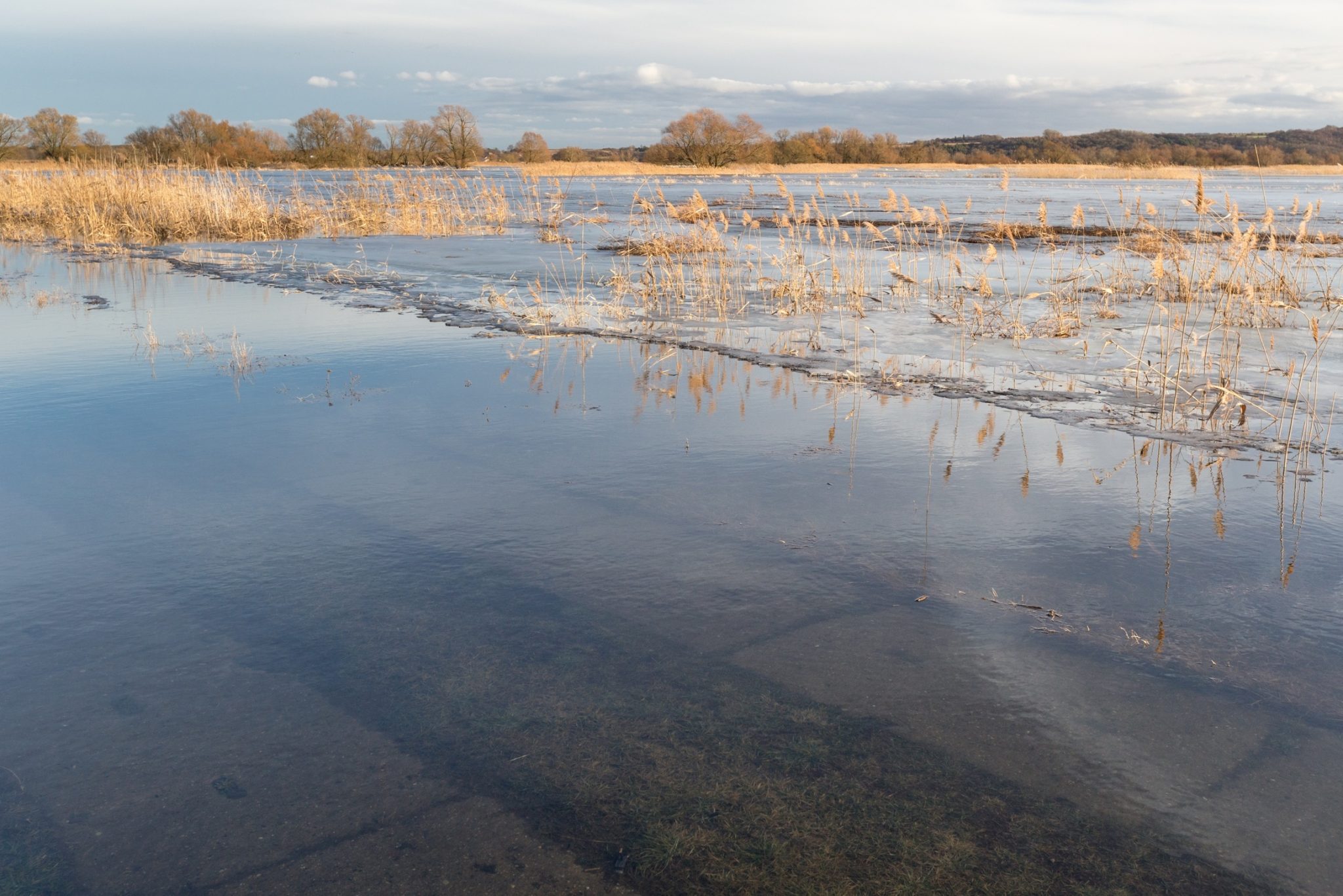Disaster

Take steps to ensure that your well water is safe after a flood. One method of disinfection is shock chlorination.
Upon Return to Your Home
After a flood, it is strongly recommended that a licensed water well driller be hired to shock chlorinate your well if the wellhead has been flooded or submerged even temporarily. A water well driller will have access to more effective products and will have equipment and experience that a typical well owner will not have. However, if you plan to attempt to disinfect your well yourself, follow the instructions below.
How to Shock Chlorinate a Water Well
If your well system is damaged, the following instructions for the disinfection process will not work. An indication that your well is damaged can be a decrease in water pressure once turned on. Contact a certified contractor for examination.
If your well is contaminated, alternative options include using bottled water, water boiled for at least 5 minutes, or water from a source you know isn’t contaminated.
The water in your well is most likely contaminated after a flood. Ingesting or being exposed to contaminated water may cause sickness. However, these instructions on how to shock chlorinate your well system may solve the issue.
Do not use contaminated water for the following:
- Drinking
- Cooking
- Making ice
- Bathing in any form
- Washing clothes or dishes
Contaminants could include the following:
- Manure
- Sewage
- Treatment plant wastewater
- Nearby flooded septic system matter
To ensure a safe and effective disinfection process, follow these step-by-step directions:
Preparation Phase
Tools Needed
- A garden hose long enough to reach from an outdoor water faucet to the well
- Protective goggles and gloves
- Clean 5-gallon bucket
- 5 gallons of water
- Funnel
- Unscented household liquid bleach less than 6 months old
How to calculate how much bleach you need:
- The amount of bleach to be used in the disinfection process will depend on the amount of water in the well.
- To calculate the water volume, subtract the static water level (distance from land surface to the water in the well) from the total depth of the well. If you don’t know the static water level, use the total measurement of the well depth. See table 1.
Table 1. Amount of Unscented, Household Liquid Chlorine Bleach Needed for Well Disinfection
| Water depth in well (feet) | Well diameter: 4 inches | Well diameter: 6 inches | Well diameter: 8 inches | Well diameter: 24 inches | Well diameter: 36 inches |
|---|---|---|---|---|---|
| 10 | 6 cups | 7 cups | 8 cups | 20 cups | 2.5 gallons |
| 20 | 7 cups | 8 cups | 10 cups | 2.5 gallons | 4.5 gallons |
| 50 | 8 cups | 10 cups | 14 cups | 5 gallons | 10.5 gallons |
| 100 | 10 cups | 16 cups | 22 cups | - | - |
| 150 | 12 cups | 20 cups | 30 cups | - | - |
| 200 | 14 cups | 1.5 gallons | 2.5 gallons | - | - |
| 400 | 22 cups | 2.5 gallons | 4.5 gallons | - | - |
4 cups = 0.25 gallon; 8 cups = 0.5 gallon; 12 cups = 0.75 gallon; 16 cups = 1 gallon
STEP-BY-STEP INSTRUCTIONS
STEP 1: Clear Well of Sediments:

Figure 1. Different well access possibilities
- If you have noticed cloudy or muddy water coming from the well, connect a garden hose to an outside faucet.
- Turn on water at the faucet, and let it run until water is clear and free of sediments.
STEP 2: Turn Off Power
- Turn off electrical power to the pump by turning off the circuit breaker.
- Disconnect water softeners or household water filters by switching to bypass mode or the out-of-service position.
STEP 3: Open the Well
- Remove all debris near the well. Check the well for damage. Remember, if your well is damaged, this process will not work.
- For a well seal (figure 1A), remove the threaded well plug for access; for a well cap (figure 1B) or sanitary cap (figure 1C), remove the bolts from the cap and lift for access.
- If your well system does not look like the options in figure 1, call a contractor for further assistance.
STEP 4: Mix
- Fill the 5-gallon bucket about three-fourths full with bottled water.
- Look back at table 1 to determine how much bleach is needed.
- Add bleach to the bucket of water.
- Using the funnel, pour the bleach solution into the thread well plug or well casing.
Be careful not to splash or spill the solution.
STEP 5: Recirculate the Chlorinated Water
- Turn on the circuit breaker to the pump.
- Connect the garden hose to an outdoor faucet.
- Place the funnel into your well’s access point, and put the garden hose into the funnel.
- Turn the water on, and let it run for 30 minutes to circulate the bleach within the well.

STEP 6: Run Chlorine Solution Through Faucets
- Run the chlorinated water throughout the plumbing system. Start inside the house and work your way out by turning on each tap one at a time until you smell bleach.
- Repeat this step for both hot and cold taps, toilet and shower/bath taps, and outside faucets.
- Leave the chlorinated water in the plumbing for a minimum of 8 hours or overnight.
STEP 7: Flush Chlorinated Water
- Run the water through an outside garden hose until you no longer smell chlorine.
- Keep the running water away from your septic system, landscaping, and bodies of water.
- When the chlorine smell is gone from the well, turn on each fixture inside the house one at a time until the chlorine smell in no longer present.
STEP 8: Disinfect Water and Reconnect Treatments
- Disinfect home water softener or household filters according to the manufacturer’s instructions, and then reconnect those devices.
DO NOT DRINK THE WATER UNTIL IT HAS BEEN TESTED. THE WATER SAMPLE IS NOW READY TO BE SENT TO A LAB.
This procedure is based on well disinfection protocols from the Florida Department of Health, Minnesota Department of Health, Virginia Tech Cooperative Extension, Clemson Extension Service, Texas A&M Agrilife Extension, and Texas Commission on Environmental Quality. Adapted for Alabama by the Alabama Cooperative Extension System.
Planning Ahead
You can take action to prepare your well for a flood, even as you are making plans to evacuate. Store adequate bottled water for drinking and cooking because if your well is submerged even temporarily, you won’t be able to drink, brush teeth, or cook with the well water until it is tested and found suitable. Complete the following during your evacuation planning:
During Potential Evacuation Preparations
- Contact a nearby water testing lab or your county office of the Alabama Department of Public Health (ADPH) to obtain sample collection bottles and instructions so they will be available when you return. The Alabama Department of Environmental Management (ADEM) provides lists of current chemical and bacteriological certified labs on their web pages at http://www.adem.alabama.gov/ programs/water/waterforms/InStateChemicalLabs. pdf and http://www.adem.alabama.gov/programs/water/waterforms/BacteriologicalLabs.pdf. Your county ADPH office can test your water for bacterial contamination (fecal coliforms). ADPH provides sample bottles and instructions. If you need help locating the nearest county health office, contact your county Extension coordinator.
- Locate the log/well report completed when the well was established, and store a copy in a safe place that will be accessible if you evacuate.
- Locate contact information for licensed well drillers in your area. Contact a driller before evacuating if you think that your well will need service immediately after a flood.
- Fill the pressure tank as much as possible.
- If your water well system is in an exposed area, cover and secure components to help protect them from flying debris or inundation.
- Turn off electricity to the well.
- If you have an aerobic septic system, turn off electricity for the system. No special preparations are recommended for conventional septic systems.
- If you plan to attempt to disinfect your well yourself upon your return, have these basic shock chlorination materials available before the flood because these supplies may be difficult or time-consuming to acquire following a flood:
- Instructions on how to shock chlorinate (see step-by-step instructions)
- Unscented, household liquid bleach
- Clean 5-gallon bucket and 5 gallons of uncontaminated water
- Garden hose that reaches from an outdoor faucet to the well
- Protective goggles and gloves
- Wrench for well access
- Funnel
- Hose
- Sample collection bottles from local water testing laboratory or county health department
9. Learn how to bypass water softeners and household water filters if any are attached to your water system. Read and have manufacturer’s instructions easily available for these procedures.

